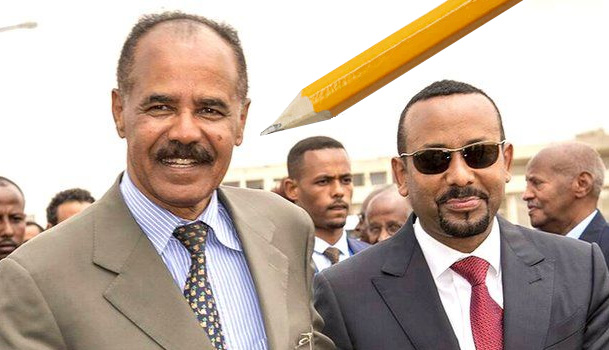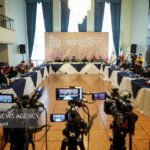
Often times, news surfaces only to be quickly subdued and forgotten, though it occasionally reemerges in surprising ways. Below is a brief list of key events:
After the liberation of Massawa in 1990, Isaias returned from London where he attended a meeting between the TPLF and EPLF to discuss the future of the two countries. The meeting was facilitated by the EU and the USA, and Herman Cohen, who played a key role in pressuring both sides to maintain unity of the two countries through a power-sharing arrangement. At the time, the Derg regime teetered on the brink of collapse.
Confederation
Upon his return, Isaias briefed senior EPLF leaders about the meeting, proposing a confederation. While most leaders refrained from expressing their views, Mesfin Hagos opposed the idea, asserting that the EPLF had promised the Eritrean people full independence—anything less would be unacceptable.
Following Eritrea’s independence in 1991, the TPLF and EPLF agreed to hold a referendum to legitimize the new Eritrean nation. In a subsequent interview with the London based Saudi newspaper Al-Asharq Al-Awsat, Isaias expressed his desire not only for good relations with Ethiopia but also for a confederation. That statement alarmed many Eritreans, including top EPLF commanders.
Soon after, the Eritrean media suggested that Isaias’ remarks were misinterpreted. Subsequently, the PFDJ launched a vitriolic campaign against the Saudi royal family, labeling them as “Turkish bastards.”
At the first conference in Addis Ababa after the Derg’s fall, TPLF, EPLF, and their Western allies debated the future of the two countries again, and confederation was the central agenda. However, the TPLF rejected the proposal, and Isaias was enticed with offers of a presidential position in the planned confederation. Both parties declined for differing reasons; the Tigrayans were wary of being sandwiched between Amhara and Eritrea. They believed they would be condemned to the role of a minor stakeholder, something they fought against; they were not willing to settle for a subordinate role.
Despite controlling the situation at home, Isaias faced significant pushback from senior EPLF leaders and had to abandon his aspiration for a confederation. After 30 years of occupation and struggle, most Eritreans rejected the proposal, save for a few aligned with previous regimes. And though Isaias was popular, he faced serious objections from the EPLF senior leaders, and he had to subdue his goal. that Eritreans would not accept except for a negligible few associated with the successive occupation.
The Historical Hindrances by Ethiophiles
In the 1940s, the unionist party resorted to bribery, corruption, intimidation, and violence to unify Eritrea and Ethiopia. The church played a significant role by threatening villagers with excommunication for not supporting the unionists. Despite pressure from Western powers, a negotiated federal arrangement was reached between Eritrea and Ethiopia under the auspices of the UN.
Haile Selassie remained dissatisfied and repeatedly attempted to suppress the Eritrean spirit of independence through military means, which ultimately failed. His successors in the Derg followed a similar violent path but ended up implementing a self-rule policy, dividing Eritrea into three self ruling regions.
After the Derg’s defeat, the EPRDF came to power, adopting a containment policy toward Eritrea. However, its ethnic-based administration reignited suppressed nationalist sentiments, leading to its downfall.
In 2018, Abiy Ahmed rose to power, and many thought he understood the complexities of the Eritrean situation. His approach, however, focused on pacifying and controlling Eritrea. He rehabilitated the old guards, forces of previous regimes, and revived the confederation idea. Despite Isaias’ experience in managing ethnic and religious divisions, in front of Abiy, his policies proved to be reckless and vague.
Abiy played a docile partner and boosted Isaias’ ego; Isaias misread Abiy’s intentions and felt very comfortable. He had already purged potential opponents who posed threats to his grip of power by exile, imprisonment, and disappearance. Furthermore, Isaias was engaged in a diligent and massive social reengineering project that confused and disoriented Eritreans. The PFDJ has altered the national narrative through school curriculums and cadre school indoctrinations, while the Sawa training camps produced a strong army that was trained to be loyal to the PFDJ; Eritrea doesn’t have either a constitution or rule of law to this day.
Over the years, Eritreans were emasculated and became so docile; they almost forgot the meaning of freedom, justice, and basic fairness. The state monopolized all national economic sectors and became the only major employer impoverishing the people. The state monopoly spread nepotism and cronyism, benefiting its select loyalists all over the world.
The Isaias-Abiy honeymoon
Abiy (at least his consultants) must have pushed him to pursue a daring two-pronged objective: decimate the TPLF, his main rival and PFDJ’s archenemy, in order to gain full control over Eritrea and it’s Red Sea shores. But to pull off the deal, Abiy must guarantee Isaias a handsome power sharing deal. Thus, Abiy stealthily resurrected the old proposal: offering Isaias the position of president of an Eritrean-Ethiopian confederation while Abiy keeps the position of prime minister. If that had worked, Isaias would have been in the ex-Ethiopian president, Sahle-work Zewed’s shoes; she resigned (or was pushed out) two days ago and was replaced by Taye Atske-Selassie.
The Abiy-Isaias deal didn’t get through, and many are glad it didn’t. The two-man deal would have created a worse situation in the violently chaotic region.
Abiy had planned the game perfectly. When Isaias visited Ethiopia, Aby cajoled him like a bride-to-be. He took Isaias to visit his grandfather’s grave in Gondar (Abiy stated he is buried there). In addition, Abiy prepared lavish receptions in many Ethiopian cities to honor Isaias who was received like a pop star as the audience screamed like teenagers. Many traditional leaders warmly received Isaias and showered him with gifts of swords, shields, horses, and camels. In a reception,
Abiy had recognized the Eritrean-Ethiopian border demarcation snug that was stalled despite a clear ruling by the International Court of Arbitration (ICC). He promised to immediately implement the ruling and diligently worked to help lift the sanctions imposed on Eritrea for years. He delivered on that promise. Finally, the borders were opened, bringing Eritrea out of the decade’s old isolation.
In a state dinner, Isaias had an emotional meltdown when Abiy literally put a ring on Isaias’ finger. On another occasion, Isaias told Abiy. “You are our leader, lead us and we will follow you.” In another interview, Isais added, “if anyone believes that the two countries [Eritrea and Ethiopia] are different, he must be living in a different world.” PFDJ loyalists and other officials mimicked the tone and message almost verbatim. And the late Alamin Mohammed Saeed, the PFDJ secretary, declared, “Our main goal is to protect Ethiopia from fragmentation.” The parties continued … for a while.
In 2021, Abiy was fully convinced he couldn’t pursue his ambitions while the TPLF was around; it was in synch with Isaias’ views. In tandem, they launched a massive attack on Tigray, totally decimating it and destroying its economic, educational, and healthcare infrastructure. It seemed as if they succeeded. …just for a while
In 2022, the Tigray war ended, and it led to the Pretoria Agreement between the Ethiopian federal and Tigray regional governments.
Just like in 1991, the Tigrayans would not accept being sandwiched between the Amhara and Eritrea. Also, Ethiopian ethnic strife, feudal and ultra-nationalist sentiments, and palace governance will not be reformed any time soon. In addition, for some unknown (and foolish) reason, Isaias was not part of the Pretoria meeting; his exclusion proved to be detrimental for the Pretoria agreement. It’s like the last nail on the coffin of Abiy’s [and Isaias’] goals and ambitions. With that, Abiy’s theatrics, as well as Isaias’ manufactured humility, came to an end. Finally, with the raging, or brewing, conflicts in Ethiopia, the situation is back to square one.
It has been a while since Abiy started to pursue an expansionist policy to gain control over some real estate on the Red Sea Shore. However, it’s a habit of Ethiopian politicians to make deadly mistakes: they don’t consider the will and sentiments (and reactions) of the common people but their leaders! It’s a mindset that sees the art of governing through feudal glasses.
So, what ultimately caused the fallout between Abiy and Isaias?
The region’s politics and culture are elusive; attentive observation is crucial, for forgetfulness remains to be the greatest enemy of the Horn of Africa.

















